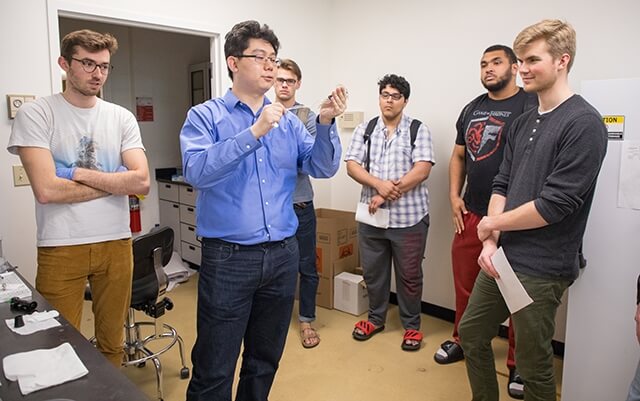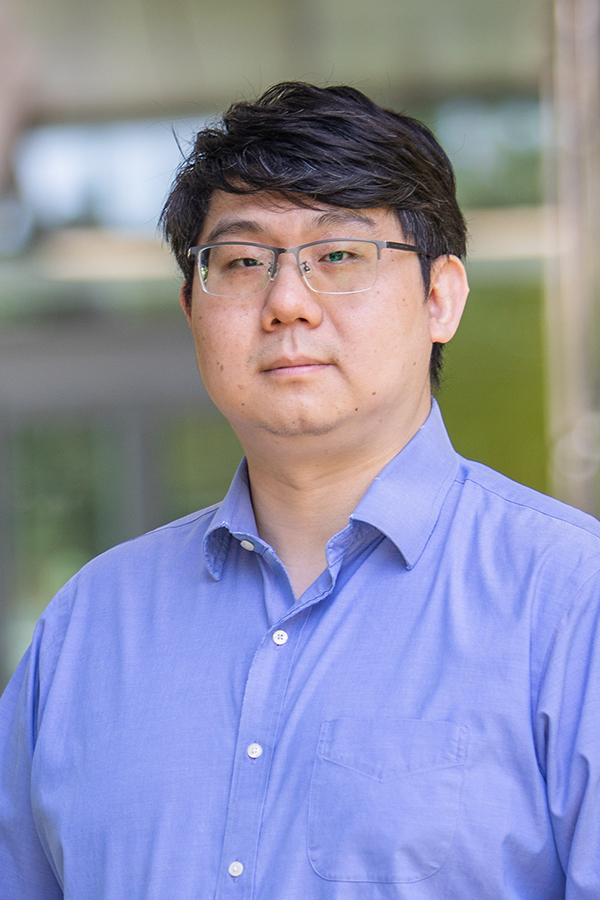News
A computer and a human brain are, in many ways, more alike than they are different. A computer’s central processing unit contains billions of integrated transistors; the brain is comprised of billions of integrated neurons.
Seamlessly integrating electronic components into biological systems could help scientists unlock the secrets of brain function, as well as develop tools to treat a variety of neurological diseases. But effectively combining rigid electronics with soft biological systems is an intricate puzzle that has stymied researchers.
This quandary forms the core of Introduction to Bioelectronics (BE 129), a new course at the Harvard John A. Paulson School of Engineering and Applied Sciences (SEAS) that prepares students for careers in the burgeoning field of bioelectronics.
“Working in the field of bioelectronics requires a highly interdisciplinary background,” said course instructor Jia Liu, Assistant Professor of Bioengineering. “Students need to understand principles from biochemistry, bioengineering, neuroscience, electrophysiology, electrical engineering, and even mechanical engineering. Bringing all those fields together in one course is a challenge.”
The bioelectronics field has existed since before humans even discovered stable electricity. In the mid-18th century, Italian physician Luigi Galvani famously demonstrated the use of electrodes to stimulate a dead frog’s legs and make them move.
Today, the field is focused on developing biomedical devices to help monitor neural activity and provide therapeutic stimulation to treat neurodegenerative diseases like Alzheimer’s, Huntington’s, autism, and epilepsy, Liu said.
The field of bioelectronics has come a long way, as evidenced by the cutting-edge equipment in Liu's lab. (Photo by Eliza Grinnell/SEAS Communications)
But even studying the brain’s electrical systems is a challenge, since it is comprised of more than 80 billion interwoven neurons and trillions of synapses, groups of which constantly turn on and off.
“We need a better understanding of our brain, not just through further improvement of our computing systems, but also through building a better brain-machine interface,” he said. “In addition, making machines part of us through advanced human-machine interfaces could significantly improve the performance of natural biological systems and enable us to further leverage massive computing powers from man-made devices for ourselves.”
It’s a lofty goal that only a few years ago would have been science fiction, but now students at SEAS are learning the tools to take on these complex biological challenges.
In BE 129, lectures cover the fundamental principles of biochemistry and neuroscience, but also the nuts and bolts of electrical engineering, metals, semiconductor transistors, and circuits. Case studies showcase how electronics are designed for organ-level interfaces, including bioengineering solutions for neural engineering, cardiovascular engineering, and wearable devices.
In addition to covering the feasibility of the human-machine interface, the course also included discussions about the potential limitations and ethics of applying such techniques for our society.
And experimental demos show how different disciplines come together into physical solutions. For instance, one demo involved the creation of a fully stretchable, miniature printed circuit board to be used as a skin-like, wearable device for field potential recording, such as an electrocardiogram.
Liu uses the demos to underscore how important it is for students to have a mastery of fundamental principles when designing bioelectronic devices. Proper design plays a critical role in a device’s ability to interface with a biological system, he said.
Liu uses demos to show students how important it is for them to understand fundamental principles when designing bioelectronic devices. (Photo by Eliza Grinnell/SEAS Communications)
The course’s interdisciplinary focus inspired bioengineering concentrator Caleb Ringkob, S.B. ’19, to enroll.
“BE 129 taught me how to integrate biology, electrical engineering, and biomedical engineering skills from my coursework and research,” he said. “This will benefit me in any future positions that require interdisciplinary knowledge and the ability to communicate with different sub-teams with specific disciplines.”
Daniel Soberanes, A.B. ’20, a joint concentrator in biomedical engineering and neuroscience, was especially interested in learning about the future of the bioelectronics field, including the challenges it faces going forward.
“The most poignant lesson I learned from BE 129 is that the human brain is the most sophisticated and complex machine that we have access to, and if we are one day able to understand how it works, we will have the ability to make sure everyone is able to live life to the fullest,” he said.
Liu hopes the course inspires students, showing them how far the field has come from its humble, frog-leg beginnings, and gives them a glimpse of what the future may hold.
“We are talking about how these devices integrate with a human being, from a molecular level through the cells to the tissue. That kind of integration and design will fundamentally change who we are as humans, and that makes it critical for places like Harvard to start to cultivate these ideas, deliver them to students, and embrace this future,” he said. “This kind of a course requires a place like Harvard, which has strong engineering but also very strong basic sciences and liberal arts, so we can merge these disciplines together.”
Topics: Academics, Bioengineering
Cutting-edge science delivered direct to your inbox.
Join the Harvard SEAS mailing list.
Scientist Profiles
Jia Liu
Assistant Professor of Bioengineering
Press Contact
Adam Zewe | 617-496-5878 | azewe@seas.harvard.edu




